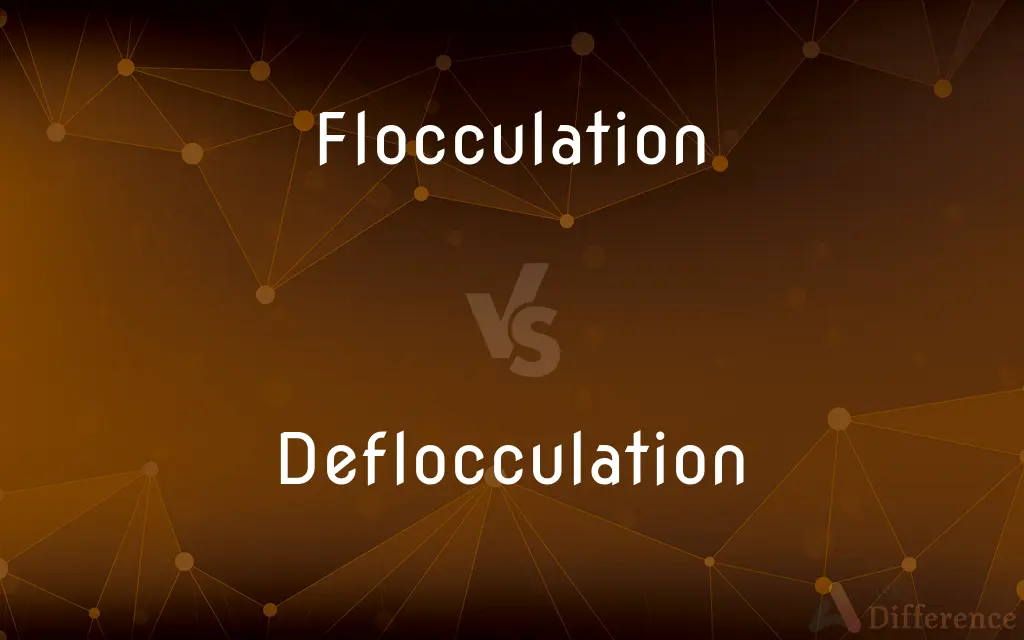Flocculation vs. Deflocculation — What's the Difference?
By Tayyaba Rehman & Urooj Arif — Updated on March 12, 2024
Flocculation involves particles clumping together in a fluid, while deflocculation is the process of breaking up these clumps to stabilize the dispersion.

Difference Between Flocculation and Deflocculation
Table of Contents
ADVERTISEMENT
Key Differences
Flocculation is a process where suspended particles in a fluid come together to form larger clumps, or "flocs," usually through the addition of a flocculating agent or under certain physical conditions. This process is often used in water treatment to remove contaminants and in industries to enhance the separation of solids from liquids. Deflocculation, on the other hand, involves dispersing these particles back into the fluid, preventing them from clumping together. This is achieved through chemical additives that increase the repulsive forces between particles, leading to a stable dispersion.
In flocculation, the goal is often to aggregate particles to facilitate their removal or processing. For example, in water treatment, flocculants help bind impurities together, making them easier to filter out. Deflocculation is desired when the aim is to maintain a homogeneous mixture, such as in paints and ceramics, where evenly dispersed particles are essential for product quality.
The agents used in flocculation and deflocculation are key to their processes. Flocculants, which can be organic or inorganic, encourage clumping by reducing the repulsive forces between particles. Deflocculants, like dispersants or plasticizers, work by increasing the electrostatic or steric repulsion between particles, keeping them uniformly dispersed.
The application of these processes is widespread across various industries. Flocculation is critical in water treatment, mining, and paper manufacturing, where solid-liquid separation is a fundamental step. Deflocculation is crucial in paint manufacturing, ceramics, and pharmaceuticals, where product consistency and stability are paramount.
Despite their opposing objectives, both processes are essential for achieving desired outcomes in their respective applications. Flocculation enhances the efficiency of separation techniques, while deflocculation ensures the stability and uniformity of mixtures.
ADVERTISEMENT
Comparison Chart
Objective
To clump particles together
To disperse and stabilize particles
Application
Water treatment, mining, paper manufacturing
Paints, ceramics, pharmaceuticals
Agents Used
Flocculants (organic or inorganic)
Deflocculants (dispersants, plasticizers)
Desired Outcome
Enhanced solid-liquid separation
Homogeneous and stable mixtures
Process
Reduction of repulsive forces between particles
Increase in electrostatic or steric repulsion between particles
Compare with Definitions
Flocculation
Process of particles clumping together in a fluid.
Adding alum to water causes flocculation of impurities.
Deflocculation
Critical in maintaining the stability of suspensions like paints and inks.
Deflocculation in paint prevents pigment settling and ensures uniform color.
Flocculation
Aimed at improving the efficiency of filtration or sedimentation processes.
Flocculation in brewing clarifies beer by settling yeast particles.
Deflocculation
Ensures product quality by maintaining consistency and preventing settling.
Deflocculated glazes in ceramics produce even, defect-free surfaces.
Flocculation
Often used in water treatment to aggregate contaminants for easier removal.
Flocculation tanks in wastewater plants improve sedimentation.
Deflocculation
Achieved through chemical additives that increase repulsion between particles.
Electrolytes in pharmaceuticals act as deflocculants to stabilize suspensions.
Flocculation
Involves the addition of flocculating agents to facilitate particle aggregation.
Polymers are used as flocculants in the paper industry to enhance pulp processing.
Deflocculation
Widely used in industries where homogeneous mixtures are essential.
In cosmetics, deflocculation ensures lotions remain smooth and uniform.
Flocculation
Essential for various industrial processes requiring solid-liquid separation.
In mining, flocculation helps in the recovery of valuable minerals from slurry.
Deflocculation
The process of dispersing particles in a fluid to prevent clumping.
Deflocculants in ceramic slip ensure a smooth, pourable mixture.
Flocculation
Flocculation, in the field of chemistry, is a process by which colloidal particles come out of suspension to sediment under the form of floc or flake, either spontaneously or due to the addition of a clarifying agent. The action differs from precipitation in that, prior to flocculation, colloids are merely suspended, under the form of a stable dispersion, in a liquid and are not truly dissolved in solution.Coagulation and flocculation are important processes in water treatment with coagulation aimed to destabilize and aggregate particles through chemical interactions between the coagulant and colloids, and flocculation to sediment the destabilized particles by causing their aggregation into floc.
Deflocculation
The dispersion of an aggregate to form a stable colloid; the reverse of coagulation or flocculation
Flocculation
To cause (individual particles of clay) to aggregate into clotlike masses or precipitate into small lumps.
Flocculation
To cause (clouds) to form fluffy masses.
Flocculation
To form lumpy or fluffy masses.
Flocculation
A condition in which clays, polymers or other small charged particles become attached and form a fragile structure, a floc.
Flocculation
The process by which small particles of fine soils and sediments aggregate into larger lumps.
Flocculation
The process of flocculating; forming woolly cloudlike aggregations
Common Curiosities
Can flocculation occur naturally?
Yes, it can occur naturally under certain conditions, like in rivers where colloidal particles aggregate due to changes in salinity or pH.
Why are deflocculants important in paint manufacturing?
They prevent pigment particles from clumping together, ensuring the paint remains smooth and consistent in color and texture.
How do flocculants work?
Flocculants work by reducing the repulsive forces between particles, allowing them to come closer and form larger aggregates.
What role does deflocculation play in ceramics?
It ensures that ceramic slips are smooth and pourable, maintaining an even dispersion of particles for high-quality finished products.
How does deflocculation differ from flocculation?
Deflocculation involves dispersing particles to prevent clumping and maintain stable, homogeneous mixtures, opposite to flocculation's goal of aggregation.
What is the purpose of flocculation?
The purpose is to aggregate particles into larger clumps for easier removal or processing, commonly used in water treatment and various industrial applications.
Can flocculation be beneficial in environmental cleanup?
Yes, flocculation can be used to aggregate and remove pollutants from water bodies, aiding in environmental cleanup efforts.
Are there environmental concerns associated with flocculation?
Yes, the choice and disposal of flocculants need to be managed carefully to avoid environmental harm, especially in water treatment processes.
What industries rely heavily on flocculation?
Industries like water treatment, mining, paper manufacturing, and brewing rely on flocculation for effective solid-liquid separation.
Can deflocculation affect the viscosity of a mixture?
Yes, by preventing particle aggregation, deflocculants can reduce the viscosity of suspensions, making them easier to handle and apply.
How do deflocculants aid in pharmaceuticals?
They stabilize suspensions, preventing the active ingredients from settling, thus ensuring uniform dosage and efficacy.
What factors influence the effectiveness of flocculation?
Factors include the type and concentration of flocculant, the nature of the particles, and the conditions of the fluid, such as pH and temperature.
How are flocculants and deflocculants chosen for a specific application?
They are chosen based on their compatibility with the fluid and particles, desired outcome, and environmental considerations.
Is there a way to reverse flocculation?
Flocculation can sometimes be reversed by altering the conditions that led to aggregation, such as changing pH, or by adding deflocculating agents.
What are the challenges in deflocculation processes?
Challenges include finding the right balance of deflocculant to achieve stable dispersion without adversely affecting the product's properties or performance.
Share Your Discovery

Previous Comparison
Legendary vs. Mythical
Next Comparison
Endure vs. SurviveAuthor Spotlight
Written by
Tayyaba RehmanTayyaba Rehman is a distinguished writer, currently serving as a primary contributor to askdifference.com. As a researcher in semantics and etymology, Tayyaba's passion for the complexity of languages and their distinctions has found a perfect home on the platform. Tayyaba delves into the intricacies of language, distinguishing between commonly confused words and phrases, thereby providing clarity for readers worldwide.
Co-written by
Urooj ArifUrooj is a skilled content writer at Ask Difference, known for her exceptional ability to simplify complex topics into engaging and informative content. With a passion for research and a flair for clear, concise writing, she consistently delivers articles that resonate with our diverse audience.















































